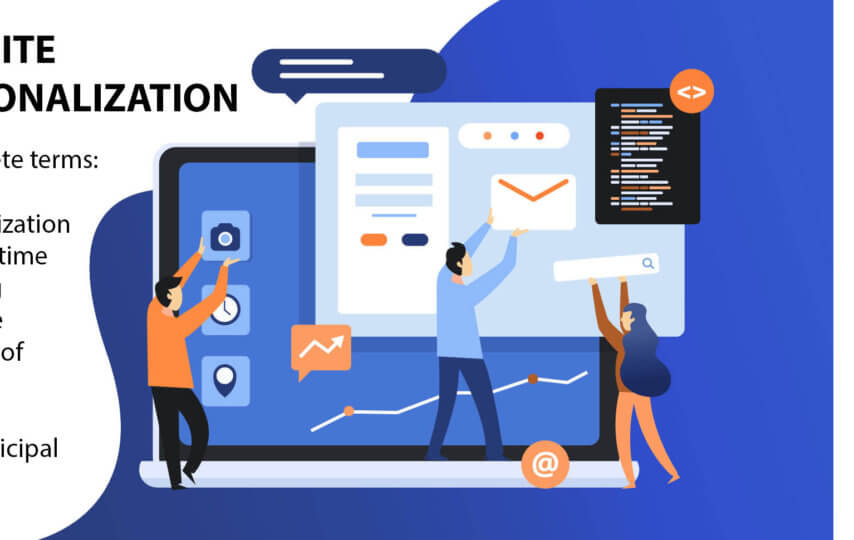In concrete terms: website personalization and real-time targeting using the example of energy suppliers and municipal utilities
Website personalization is seen by many as a very abstract topic. You know that the idea is theoretically good and correct, but you can’t really imagine how it should be used on your own website.
With this example we would like to show a specific use case to lift the important topic from the theoretical level to the real business world. We have decided on an industry that everyone knows: energy suppliers. Let’s go.
Nevertheless, many companies find it difficult to imagine how a personalization strategy can be implemented on their own company website. Not only efforts but also costs are spared.
But wanting to use website personalization and real-time targeting does not mean that the entire website has to be relaunched.
Using a specific example, we show how small changes can have big effects. The case can be applied to the large electricity providers as well as to regional companies in the energy sector or municipal utilities.
Geolocation: Easy entry with great impact for business in the surrounding area
For those of you who are wondering why you should personalize a website in the first place, let’s take up the customer segmentation of our example company at this point. An energy supplier’s customers are more segmented than you might think. Everyone needs electricity, but different customer groups have very different requirements.
An energy supplier located in a big city ideally not only supplies the city’s residents, but also customers from the surrounding area. Of course, they have to be addressed differently than the city dwellers and their lifestyle means that they also have completely different needs.
In Universal Messenger, the access location is automatically recorded and saved for every website visit.
Evaluating the IP address and thus assigning a website visitor to their respective access location is that easy.
Best practice: geolocation for energy providers
Business in the surrounding area can be very lucrative for energy suppliers, but marketing it can be difficult. Many potential customers do not even know that the electricity provider from the nearest city also offers a tariff for their own house.
Example: If the website visitor accesses directly from the city, the following view is used.
The following personalized elements can be identified:
- Image with clear city focus
- The intro text creates closeness and local color
- The teasers match the usage situation, e.g. moving into your first own apartment
- In addition, the teasers enable an evaluation of the click behavior, but more on that later.
A counterexample: If a website visitor from the surrounding area accesses the electricity provider’s website, the website changes automatically in the following areas:
- Stage or imagery
- Title and the intro text
- Related Links
The imagery places a stronger focus on nature and ecological aspects. The teasers also emphasize the central message for potential customers from the surrounding area, namely that a power supply is also possible in their place of residence. The statement is reinforced by the link to “Energy for the Region”
For such an anonymous personalization, the electricity supplier does not need any data other than the website user’s IP address. Despite the small amount of information about the visitor, comprehensive targeting can take place, which addresses special wishes and needs and delivers the appropriate content. The question of the relevance of the provider is thus clearly clarified and the customer feels well understood and in good hands.
Next step: Skillful personalization according to target groups
The website personalization methods described above can be used before the user has even made a single click on the website. But the limits of the personalization options are far from being reached. The behavior of anonymous users can also be evaluated in a targeted manner. In this way, users can be assigned to a target group, whereby further personalization can be carried out depending on the target group affiliation.
This can be done automatically by the Universal Messenger, for example on the basis of the scoring method. Contents are assigned a previously agreed score, with clicks on the corresponding contents the user collects scoring points in this subject area. If a user clicks on “Offers for families” in the screenshot above, they will be assigned a corresponding score for the family topic.
The more content is clicked on a certain topic (for example “family”), the more clearly the target group is defined. As soon as a user can be sorted accordingly, the content can be adjusted – of course also in the mobile website view, as the following example shows.
Here, too, the imagery and texts have been adapted, and appropriate products and offers are also teased, in this example a baby bonus. The more precisely the target group can be defined, the more precisely it can be addressed. This makes it much easier to acquire new customers, as the relevance of certain products and offers is automatically determined, even for anonymous users.
For municipal utilities – personalization in several divisions
Municipal service providers can act as a specific blueprint for cross-divisional personalization. For example, municipal utilities that not only offer energy, but also other services, including pool operation, disposal services and the like.
If a user has already been assigned to a target group, for example the “family” target group, this information can be used for cross-departmental personalization. A father not only has certain demands on his electricity tariff, but is also likely to be the right customer for a transport offer for schoolchildren. Custom web development services opens up new market segments for website users across all areas.
The user can also be given options for “manual” adjustment of the scoring. If other personalization categories are offered for selection, the scoring can be refined if necessary. Such a navigation also offers other target groups direct access to the areas of the website that are relevant to them. For the website operator, this means that the scoring model can be applied more quickly.
Conclusion
Website personalization doesn’t have to be a dip in the deep end. With simple adjustments, already existing content can be used for a personalization strategy. In addition, information that has already been collected can be used after a conversion has taken place. In this way, website personalization can be expanded from new customers to existing customers in order to promote customer loyalty.
- Personalized content can also be displayed to anonymous website users
- Small changes can have a big impact
- Website personalization is scalable and can be expanded after a conversion













